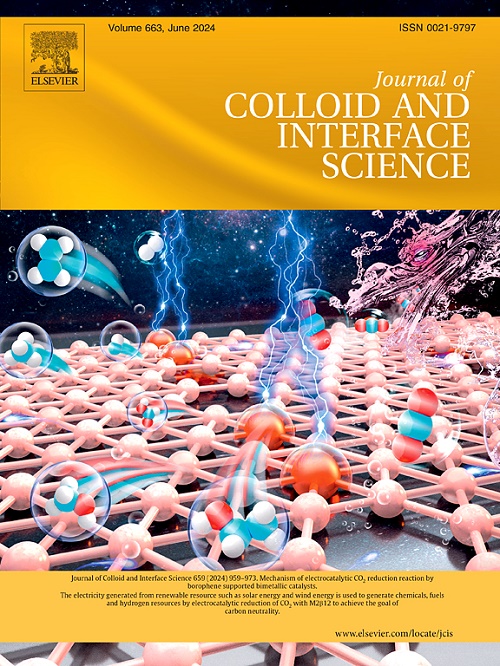Direct measurement of surface interactions experienced by sticky microcapsules made from environmentally benign materials
IF 9.7
1区 化学
Q1 CHEMISTRY, PHYSICAL
引用次数: 0
Abstract
We present a study combining experimental measurements, theoretical analysis, and simulations to investigate core–shell microcapsules interacting with a solid boundary, with a particular focus on understanding the short-range potential energy well arising from the tethered force. The microcapsules, fabricated using a Pickering emulsion template with a cinnamon oil core and calcium alginate shell, were characterized for size ( in diameter) and surface charge . We employed total internal reflection microscopy and particle tracking to measure the microcapsule-boundary interactions and diffusion, from which potential energy and diffusivity profiles were derived. The potential energy profile characterizing the normal interaction was analyzed and simulated by considering electrostatic, gravitational, van der Waals, and tethered forces, while the lateral diffusivity was compared to that of a solid particle-boundary interaction, inclusive of hydrodynamic forces. The diffusivity was represented as a normalized diffusion coefficient to eliminate the impact of fluid viscosity. The normalized diffusion coefficient of polymer-shell microcapsules (∼0.02) was found to be an order of magnitude smaller than that of solid polystyrene particles (∼0.2). The microcapsule sampled a potential well consisting of two distinct minima, as observed experimentally and supported by analytical expressions and Brownian dynamics simulations. A critical tethered height and the alginate radius of were obtained from fitting our model to experimental data. This work concludes that these benign core–shell microcapsules interact with a nearby boundary via a transient tethering interaction, overall producing a mild ‘sticky’ interaction that would likely be beneficial for applications in consumer products.

由环保材料制成的粘性微胶囊所经历的表面相互作用的直接测量。
我们提出了一项结合实验测量、理论分析和模拟的研究,以研究核壳微胶囊与固体边界的相互作用,特别关注于理解系绳力产生的短程势能阱。该微胶囊采用皮克林乳液模板,以肉桂油为核心,海藻酸钙为外壳,其尺寸为(~ 5-6μm),表面电荷为(~ -20mV)。我们利用全内反射显微镜和粒子跟踪技术测量了微胶囊与边界的相互作用和扩散,并由此导出了势能和扩散率曲线。考虑静电、引力、范德华力和系绳力,分析和模拟了正常相互作用的势能分布,并将横向扩散系数与固体粒子边界相互作用的横向扩散系数进行了比较,包括水动力。为了消除流体粘度的影响,将扩散系数表示为归一化扩散系数。聚合物壳微胶囊的归一化扩散系数(~ 0.02)比固体聚苯乙烯颗粒的归一化扩散系数(~ 0.2)小一个数量级。微胶囊取样了一个由两个不同的极小值组成的势阱,这是实验观察到的,并得到了解析表达式和布朗动力学模拟的支持。将模型与实验数据拟合得到临界系留高度hct=46.3nm,藻酸盐半径rg=32.1nm。这项工作的结论是,这些良性的核-壳微胶囊通过瞬态系绳相互作用与附近的边界相互作用,总体上产生温和的“粘性”相互作用,这可能有利于消费品的应用。
本文章由计算机程序翻译,如有差异,请以英文原文为准。
求助全文
约1分钟内获得全文
求助全文
来源期刊
CiteScore
16.10
自引率
7.10%
发文量
2568
审稿时长
2 months
期刊介绍:
The Journal of Colloid and Interface Science publishes original research findings on the fundamental principles of colloid and interface science, as well as innovative applications in various fields. The criteria for publication include impact, quality, novelty, and originality.
Emphasis:
The journal emphasizes fundamental scientific innovation within the following categories:
A.Colloidal Materials and Nanomaterials
B.Soft Colloidal and Self-Assembly Systems
C.Adsorption, Catalysis, and Electrochemistry
D.Interfacial Processes, Capillarity, and Wetting
E.Biomaterials and Nanomedicine
F.Energy Conversion and Storage, and Environmental Technologies

 求助内容:
求助内容: 应助结果提醒方式:
应助结果提醒方式:


